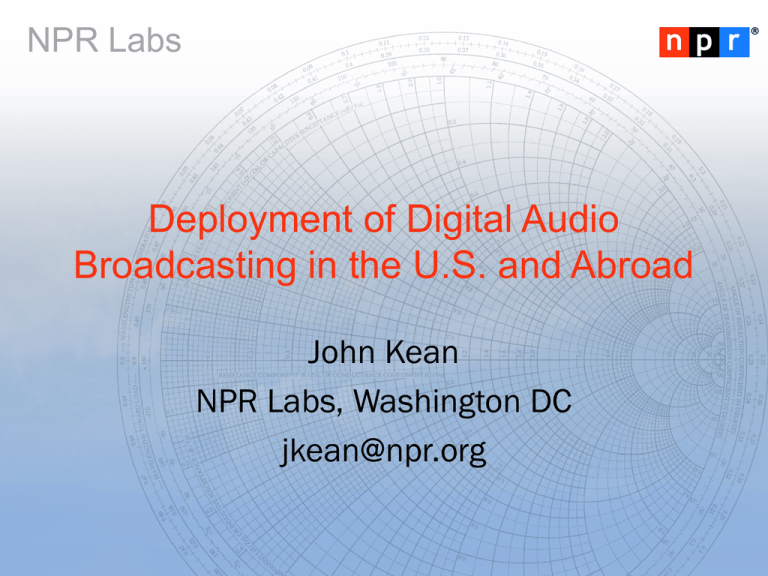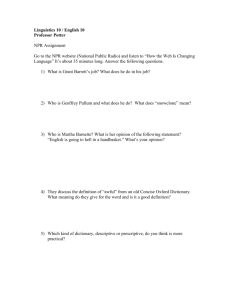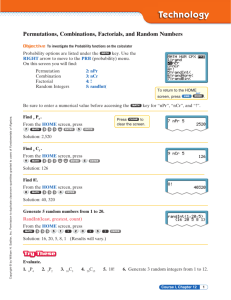Deployment of Digital Audio Broadcasting in the U.S. and Abroad
advertisement

® NPR Labs Deployment of Digital Audio Broadcasting in the U.S. and Abroad John Kean NPR Labs, Washington DC jkean@npr.org Frequency Bands of Terrestrial DAB Source: World Broadcasting Unions NPR Labs ® DAB (Eureka-147) • Initiated as a European research project in the 1980s for mobile, portable and fixed • 3 main elements, all ETSI TS 102 563 • Digital transmission coding & multiplexing (5-7 services) • COFDM modulation, 1.54 spectrum • Mostly L-Band, but in U.K., 12.5 MHa of Band III (217.5-230) • MUSICAM (MPEG-2 layer III) perceptual coding NPR Labs ® International Rollout of DAB, DAB+ World DMB Forum • • • • • Now in more than 20 countries, >1000 stations Reaching >100 million in Europe, 500 million worldwide UK DAB listeners estimated at 20 million Shown to be ~ 3.2 times more spectrum-efficient than FM Also DMB (Digital Multimedia Broadcasting) • Usually considered a digital mobile video platform • MPEG-2 transport stream packets with additional block coding • In use in Korea, Germany, numerous test countries • DAB+ standardized in 2006 • Added new HE-AAC v2 audio codec, surround sound • New frequency bands • Launches in Australia, Switzerland, Italy, Germany, etc. NPR Labs ® International Rollout of DAB Variants source: World DMB Forum Regular services Australia, Belgium, China, Czech Republic, Denmark, Germany, Hong Kong, Malta, Netherlands, Norway, South Korea, Sweden, Switzerland, United Kingdom, Canada Trials or regulation to permit Austria, Brunei Darussalam, Chinese Taipei, Croatia, France, Ghana, Hungary, Indonesia, Ireland, Israel, Italy, Kuwait, Malaysia, New Zealand, Poland, South Africa, Spain, Vietnam NPR Labs ® L-Band Frequencies Assigned to DAB Block Center Frequency (MHz) LA 1452.960 LB 1454.672 LC 1456.384 LD 1458.096 LE 1459.808 LF 1461.520 LG 1463.232 LH 1464.944 LI 1466.656 LJ 1468.368 LK 1470.080 LL 1471.792 LM 1473.504 LN 1475.216 LO 1476.928 LP 1478.640 NPR Labs • Used for T-DAB (terrestrial) broadcasts • WorldSpace satellite broadcasts in the 1467– 1492 MHz L sub-band • Canada uses slightly different central frequencies for L-band DAB • In many European countries DAB is limited to part of Band III, due to television and mobile two way radio ® Digital Radio Mondiale • “DRM” is an international non-profit consortium • Radio France Internationale, TéléDiffusion de France, BBC World Service, Deutsche Welle, Voice of America, Telefunken (now Transradio) and Technicolor SA • Open-standards design and implementation of platform • Principle: bandwidth is limited element, and computer processing power is cheap; modern CPUintensive RF & audio compression techniques enable more efficient use of available spectrum • Can deliver FM-comparable sound quality on frequencies below 30 MHz (LW, MW, SW) NPR Labs ® DRM: One-Fifth the Power Required for AM BBC Report on Plymouth UK tests NPR Labs ® Digital Radio Mondiale • 64-QAM, 16-QAM and 4-QAM schemes • 6.1 - 34.8 kbit/s for a 10 kHz channel • 72 kbit/s using standard 20 kHz channel • Allows very-long-distance signal propagation (a few watts on 26 MHz to 100’s of kW on LW) • Decodable with PC software and sound card • Endorsed by the ITU, approved as international standard • Australian govt. placed embargo on 6 - 26 MHz potentially suitable for use by DRM until spectrum planning can be completed • U.S. FCC rules part 73.758 (for HF-band broadcasting): "For digitally modulated emissions, the Digital Radio Mondiale (DRM) standard shall be employed." NPR Labs ® DRM+ New, for VHF Transmission 30-174 MHz VHF band 100 kHz channelization COFDM, 64-, 16-, 4-QAM Using HE-AAC audio codecs SFNs supported Up to 4 program services 1 station, 1 frequency May coexist near linked FM signal, also Band III • ETSI, official in 2009 • • • • • • • • NPR Labs ® DRM+ New, for VHF Transmission • Internationally agreed norms for FM band (88-108 MHz) protection • High power field trial in UK, Sri Lanka etc. • ITU standardization • Limited choices in receivers • Uncertain numbers of listeners NPR Labs ® HD Radio • “In-Band On-Channel”digital transmission in FM and AM bands • Only system approved for digital AM & FM by FCC • Outgrowth of DAB research in mid-late 1990s • Led primarily by large U.S. broadcast interests • Desire for one-to-a-channel assignment • Private company (iBiquity Digital) established and branded as “HD Radio” NPR Labs ® HD Radio • Originally referred to a “IBAC” (In-band Adjacent-channel) system – FM shown NPR Labs ® HD Radio • Implementation benefits • FM receivers not made obsolete • Propagation of FM band superior to L-band • Presumed ability to utilize existing transmitter system, avoid development of new band • National Radio Systems Committee support • ITU Recommendation BS.1114-4, adopted May 2003, classified as “Digital System C” NPR Labs ® HD Radio Development • In U.S. ~2100 stations, >95% FM, <5% AM • Adoption in Mexico, Phillipines, so far • “Advanced interest” in several countries Source: iBiquity NPR Labs ® HD Radio Development • Initial estimates of coverage at 1% power of FM were exaggerated • Indoor and portable coverage were substantially smaller than FM host • NRSC and iBiquity promoted and won power increase Hybrid FM Signal With OFDM Subcarriers Desired FM Channel (200 kHz) 6 dB -33 dBc -43 dBc OFDM Subcarriers at -10 dBc OFDM Subcarriers of Adj. Channel at -20 dBc NPR Labs OFDM Subcarriers at -10 dBc FM Carrier of Adj. Channel OFDM Subcarriers of Adj. Channel at -20 dBc ® HD Radio Development • In 2010, FCC adopted a blanket increase • 4X power increase, and up to 10X under signal clearance conditions to first-adjacent stations (determined in research by NPR Labs) • “Interference remediation” required for proven digital-toanalog FM interference cases • No U.S. standards to protect HD Radio from interference • IBOC DAB is subject to received interference • FM rules consider only analog-to-analog allocations – are ignorant of analog-to-digital issues NPR Labs ® Summary • Technical evolution of DAB in all forms has arguably been slow • Interest by consumers to DAB in the U.S. is still weak after a decade, despite the large number of digital FM stations in operation • Analog FM remains the majority radio service • Will the future of digital audio broadcasting move faster? Will it collide with other forms of wireless digital media? NPR Labs ®

